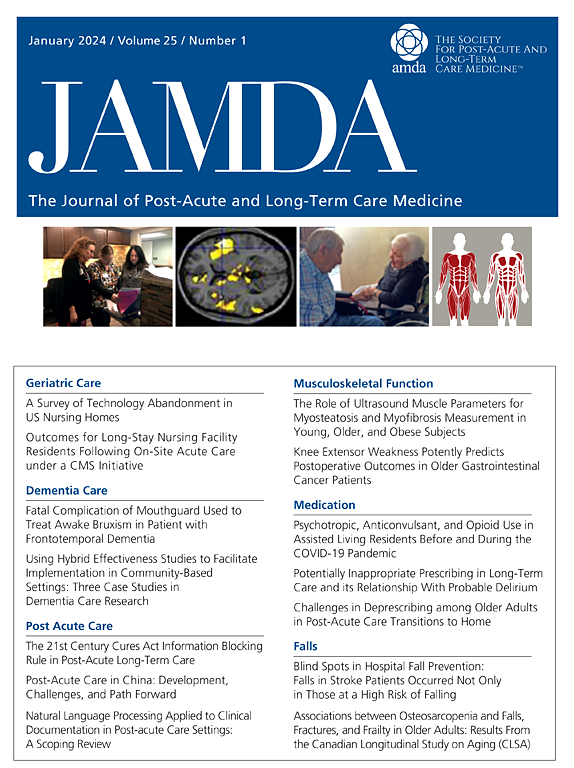运动性认知风险综合征的缓慢步速测量实践:系统回顾
IF 4.2
2区 医学
Q2 GERIATRICS & GERONTOLOGY
Journal of the American Medical Directors Association
Pub Date : 2025-01-01
DOI:10.1016/j.jamda.2024.105361
引用次数: 0
摘要
研究目的运动性认知风险(MCR)综合征患者有很高的痴呆风险。然而,作为 MCR 诊断的重要组成部分,慢步态速度的测量程序存在知识空白。该研究旨在系统回顾MCR诊断中缓慢步态速度的测量方法,以确定步态速度测量程序中的关键结构:设计:系统回顾:纳入的研究均在临床和社区环境中进行,涉及接受步速测量的 MCR 患者:方法:从开始到 2024 年 1 月,在 PubMed、Medline、Embase、CINHAL (EBSCO)、Web of Science、Cochrane Library 和 ProQuest Dissertation 等网站上进行系统检索,以获取详细的 MCR 诊断文章。研究质量采用乔安娜-布里格斯研究所(JBI)的批判性评估检查表进行评估,并通过叙事综合法对缓慢步速测量方法进行总结:从 27,600 个独立条目中,确定了 50 项相关研究和 55 个队列,并将其纳入综述。现有 MCR 研究中的慢步速度测量方法在测量工具、开始/结束方案和缓冲距离、步行测试距离、测试次数、计算方法和临界值等方面存在异质性。常见的方法是使用手动秒表和4米步行测试距离,两端各2米缓冲距离,以正常速度步行,平均2次测试进行步态速度分析,同时需要针对队列的慢步态临界值:在 MCR 诊断中,对缓慢步速的测量方法各不相同。本研究在综合分析的基础上初步确定了一个包含 7 个结构的相对全面的步速测量程序,该程序有可能提高 MCR 诊断的准确性和一致性,但仍需进一步验证。本文章由计算机程序翻译,如有差异,请以英文原文为准。
Measurement Practice of Slow Gait Speed for Motoric Cognitive Risk Syndrome: A Systematic Review
Objectives
Individuals with motoric cognitive risk (MCR) syndrome have a high dementia risk. However, a knowledge gap exists in the measurement procedure for slow gait speed, which is a crucial component of MCR diagnosis. The study aimed to systematically review slow gait speed measurement practices in MCR diagnosis to identify critical constructs in gait speed measurement procedure.
Design
Systematic review.
Setting and Participants
Included studies were conducted in clinical and community settings, involving participants with MCR receiving gait speed measurement.
Methods
A systematic search across PubMed, Medline, Embase, CINHAL (EBSCO), Web of Science, Cochrane Library, and ProQuest Dissertation from inception until January 2024 for articles with detailed MCR diagnosis. Study quality was evaluated with the Joanna Briggs Institute (JBI) Critical Appraisal Checklists and slow gait speed measurement methods were summarized through narrative synthesis.
Results
From 27,600 unique entries, 50 relevant studies with 55 cohorts were identified and included in the review. Slow gait speed measurement methods in existing MCR studies showed heterogeneity in measurement tools, start/end protocols and buffer distance, walking test distance, number of tests, calculation methods, and cutoff values. Commonly, manual stopwatches and 4-meter walking test distance with a 2-meter buffer at each end at a usual pace were used, averaging 2 tests for gait speed analysis, with the need for cohort-specific slow gait cutoff values.
Conclusions and Implications
The measurement practices of slow gait speed in MCR diagnosis were heterogeneous. A relatively comprehensive gait speed measurement procedure with 7 constructs was initially delineated in this study based on synthesis analysis, with the potential to improve diagnostic accuracy and consistency of MCR, although further validation is still needed.
求助全文
通过发布文献求助,成功后即可免费获取论文全文。
去求助
来源期刊
CiteScore
11.10
自引率
6.60%
发文量
472
审稿时长
44 days
期刊介绍:
JAMDA, the official journal of AMDA - The Society for Post-Acute and Long-Term Care Medicine, is a leading peer-reviewed publication that offers practical information and research geared towards healthcare professionals in the post-acute and long-term care fields. It is also a valuable resource for policy-makers, organizational leaders, educators, and advocates.
The journal provides essential information for various healthcare professionals such as medical directors, attending physicians, nurses, consultant pharmacists, geriatric psychiatrists, nurse practitioners, physician assistants, physical and occupational therapists, social workers, and others involved in providing, overseeing, and promoting quality

 求助内容:
求助内容: 应助结果提醒方式:
应助结果提醒方式:


